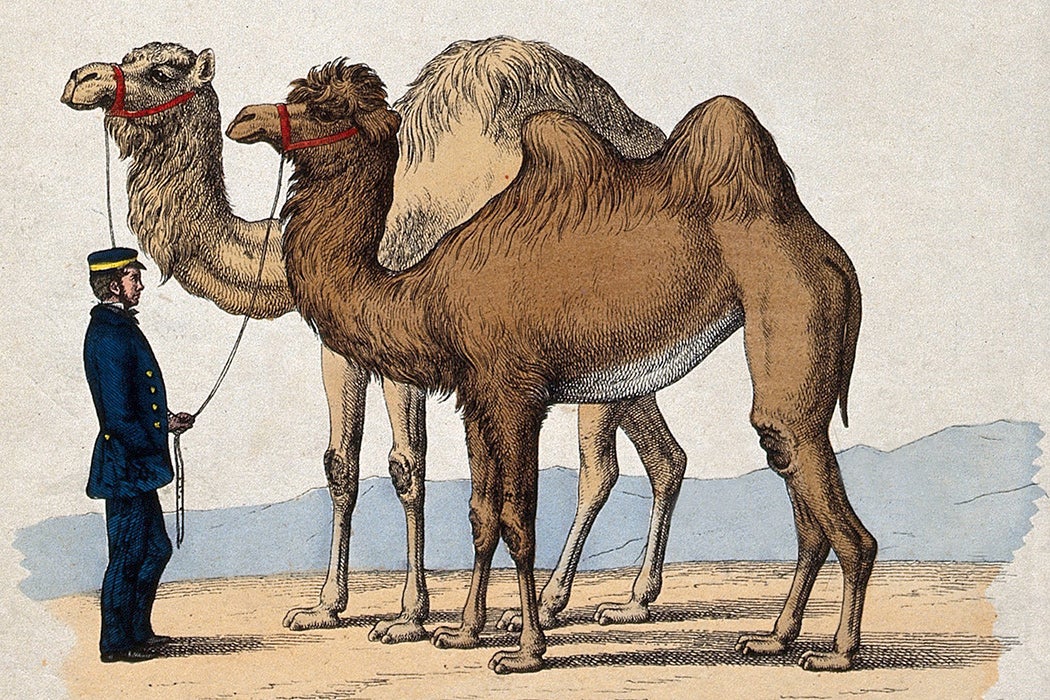The 1848 Treaty of Guadalupe Hidalgo, which ended the Mexican-American War, involved 500,000 square miles of Mexican territory, which would eventually make up all or part of the states of California, New Mexico, Arizona, Utah, Nevada, and Colorado. Much of this terrain was extremely dry, desert landscape alien to the European-Americans who hugged the temperate East. The only desert most Americans knew about was in the Bible.
Which seems to be where the camels, the ships of the desert, came in. Biblical deserts equaled camels. So why shouldn’t American desert equal the same thing? Scholar Vince Hawkins details the ups and downs of the US Army’s “Camel Corps” experiment of the mid-1850s.
The idea was born earlier, in the mid-1830s, when a lieutenant and his friend pitched the idea to the War Department, which promptly ignored it. In 1847, the lieutenant got Major Henry C. Wayne of the Quartermaster Corps interested. Wayne proposed importing camels to use for frontier military service because of the animals’ stamina, load-carrying prowess, and, of course, famous ability to go without water. A senator from Mississippi named Jefferson Davis—later president of the Confederate States—was intrigued.
Davis would be the US Secretary for War between 1853 and 1857. He particularly wanted to connect New Orleans and San Diego by railroad and was also inspired by the thought of extending slavery across the continent. In 1853, he wrote to President Franklin Pierce:
For military purposes, for expresses, and for reconnoissances [sic], it is believed, the dromedary would supply a want now seriously felt in our service; and for transportation with troops rapidly moving across the country, the camel, it is believed, would remove an obstacle which now serves greatly to diminish the value and efficiency of our troops on the western frontier.
In 1855, Congress appropriated $30,000 (some $900,000 today) to experiment with camels. Thirty-three camels were purchased from ports on the Mediterranean. Several camel drivers were also hired. All but one of the animals survived the ocean voyage to Texas, and two calves born aboard ship also made it. Forty-one more imported camels would join the force in early 1857.
The animals quickly proved better than mules. They could go for eight to ten days without water, travel thirty to forty miles a day, and eat prickly plants along the trail. The downsides? Well, they smelled, a characteristic Hawkins attributes to noses only habituated to the whiff of working horses and mules; and, while generally docile, camels could be ornery. They also spit “a large, gelatinous, foul smelling mass of cud” at people they didn’t like.
Weekly Newsletter
A new administration in March of 1857 removed the Camel Corps’s main boosters, Davis and Wayne, from the picture. Nevertheless, the program continued. Camels were useful on surveying expeditions and even successfully served in combat. But the camel experiment sputtered out as the terrible war to end Jefferson Davis’s dreams of slavery ground on.
Eventually the camels would be auctioned off. According to Hawkins, they “ended up in circuses, giving rides to children, running in ‘camel races,’ living on private ranches, or working as pack animals for miners.” Some were turned loose to fend for themselves, and camel-in-the-desert sightings were reported for years. The last one was reported to have died in Griffith Park in Los Angeles in 1934 at the age of eighty.
Editor’s Note: This article was updated to correct a backwards apostrophe.







